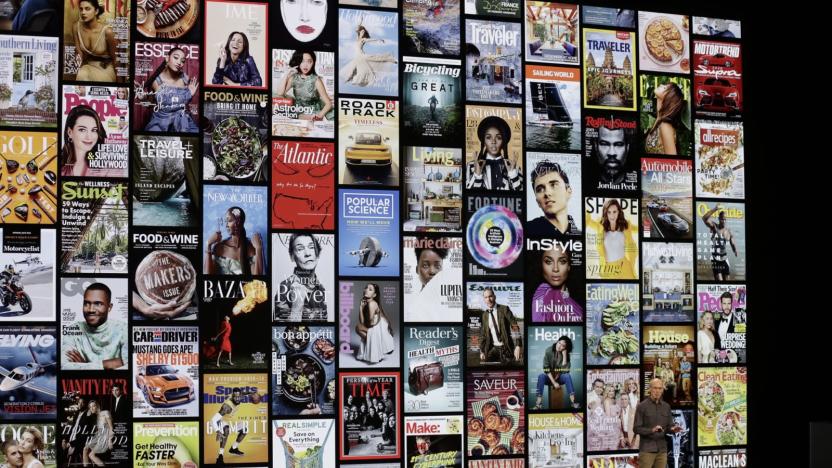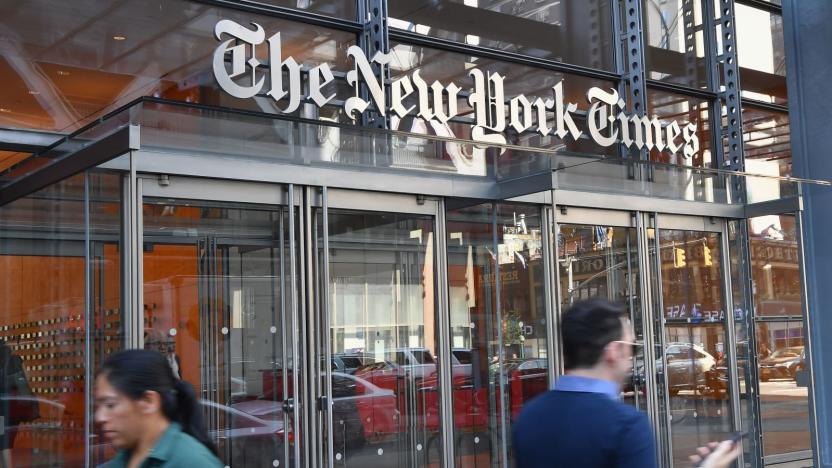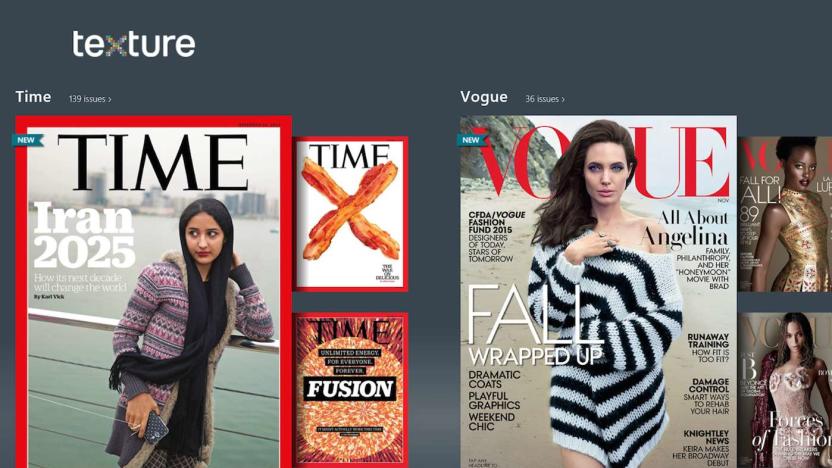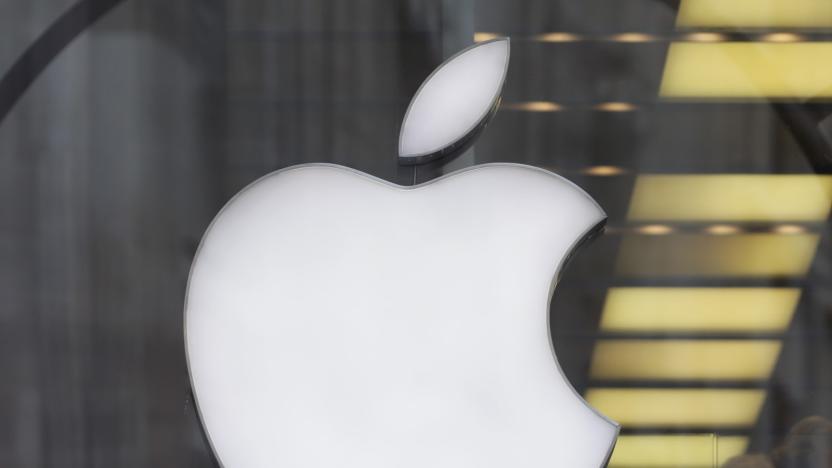Texture
Latest

Adobe's latest Lightroom smooths skin without the 'plastic' effect
Instagrammers and portrait photographers alike use Facetune-style skin smoothing techniques on photos, but it often gives your subject an overly unnatural "plastic" effect. Adobe is addressing that issue with a new plugin called Texture in its latest release of Lightroom and Lightroom Classic. It lets you do subtle retouching on portraits to reduce wrinkles and blemishes without eliminating them completely, while preserving or enhancing fine detail in pores and hair.

Apple to shut down Texture on May 28th now that News+ exists
You knew Texture wasn't long for this world once Apple News+ arrived -- and sure enough, the end is in sight. Texture has warned subscribers that its all-you-can-read magazine service will end on May 28th, 2019. You'll have a month-long free News+ trial (the same as for anyone else) to see if the new service scratches your itch. However, there's one main problem: many of Texture's subscribers can't make the jump.

Apple will reportedly reveal its news subscription service next month
Apple might face some stiff opposition in its bid to launch a subscription news service this spring. Wall Street Journal tipsters claim publishers like the New York Times and Washington Post are objecting to terms that would have Apple take "about half" of the revenue from the service, dividing the rest among publishers based on the amount of time people spend reading articles. That's a considerably higher cut than the 30 percent Apple takes during the first year of a subscription, let alone the 15 percent it takes later on.

Apple may relaunch its Netflix for magazines service in the spring
Apple may launch a new version of Texture, a magazine subscription app it bought in March, in the spring. However, publishing executives are reportedly wary of including their products in the service and potentially losing revenue to Apple's all-in-one model.

Apple seeks major newspaper allies for its subscription bundle
While rumors indicate Apple has bigger plans for its subscription bundle than just news, it has to start somewhere. In order to get that rolling, Recode reports it has opened discussions with the New York Times, Wall Street Journal and Washington Post about signing on with its recently-purchased "Netflix of magazines" app, Texture. All three have business models offering subscriptions to their news as premium pay content so it's obvious why Apple would want to include them, but less clear about whether they're inclined to join. According to Recode, Texture pays out to publishers based on how much its customers use a particular title, while the subscriptions each paper has bring money in regardless of whether a customer reads any or all of their content. Apple may have relationships with publishers via their apps and selling subscriptions in its Apple News outlet, but figuring out a way to get content aligned with a new business model could be the first hurdle to becoming an even bigger player in all forms of media.

Apple will shut down Texture's terrible Windows app
Apple bought Texture, the 'Netflix for magazines,' back in March as a clear bid to get in on an uncluttered media provider niche. The service gives subscribers unlimited access to a number of publications -- but now, you won't be able to use it on Windows devices. Without explanation, Apple informed users that the Texture app will be pulled from the Microsoft Store after June 30th. As of now, it will still be available for Android, Amazon Fire, and iOS.

Apple may add subscriptions to its News app
Apple is apparently putting its Texture purchase to use to build a subscription-based news service. Bloomberg reports that the electronics juggernaut is looking to make some changes to the way Apple News operates and that the new premium offering should launch sometime within the next year. A cut of subscription revenue will go to magazine publishers, of course. Texture's quasi-Netflix approach to reading offered all-you-can-eat magazines for $10 a month.

Apple buys Texture, the 'Netflix of magazine plans'
Apple's bids to promote digital magazines haven't always been fruitful (remember The Daily?), but it's about to give them another boost. The company has acquired Texture, the Netflix-style magazine subscription service that gives you access to a host of publications for a flat monthly fee. Apple wasn't specific about its intentions for the Texture team, but the deal reflects its commitment to "quality journalism from trusted sources." It also noted that the buyout gave it an "impressive catalog" of magazines -- the connection to major publishers (Conde Nast, Hearst, Meredith and News Corp) may be as important as the service itself.

Next Issue, the Netflix for magazines, reborn with a fresh design and new name
For those who haven't heard of it, Next Issue is best described as the Netflix of magazines: It's an app that, for a monthly fee, gives you all-you-can-read access to a large library of digital magazines. It first launched on Android in 2012 and eventually made its way to the iPad and Windows devices, although it's been ages since it received any substantial updates. That changes today, however: The app is relaunching with a new look, new features and even a new name -- it's called "Texture" now, thank you very much.

iOS 7 and the 'death of textures'
When Tim Cook said that iOS 7 marks the biggest change to iOS since the original iPhone, he wasn't kidding. If you've been able to download iOS 7 without any hiccups, you've undoubtedly noticed that iOS 7 looks different, way different. With Scott Forstall out of the mix, Jony Ive was put in charge of the look and feel of iOS and the end result is a flatter and arguably cleaner interface that does away with many of the textures users may have grown accustomed to with previous iterations of iOS. In short, iOS 7 is a whole lot flatter than its predecessor. Examining this significant shift in design, Ars Technica put together an extensive gallery highlighting a number of instances where Apple opted for a completely texture-less existence, one devoid of drop shadows, gradients and other visual cues. In one example below, we see that the new implementation of Passbook is completely shadowless. I, for one, think Apple has taken things a bit too far. While I understand that drowning in skeuomorphism isn't beneficial, I also think that running in the completely opposite direction isn't a more advantageous implementation. Overall, Ars is correct in noting that iOS 7 has brought with it the "death of textures." Oddly enough, one app some folks here at TUAW noted retained a slight semblance of texture is the Reminders app.

Autodesk researchers develop 'magic finger' that reads gestures from any surface (video)
By combining a camera that detects surfaces with one that perceives motion, Canadian university researchers and Autodesk have made a sensor that reads finger gestures based on which part of your body you swipe. The first camera can detect pre-programmed materials like clothing, which would allow finger movements made across your pants or or shirt to activate commands that call specific people or compose an email, for instance. Autodesk sees this type of input as a possible compliment to smartphones or Google Glasses (which lack a useful input device), though it says the motion detection camera isn't accurate enough yet to replace a mouse. Anyway, if you wanted that kind of device for your digits, it already exists -- in spades.

OpenGL ES 3.0 and OpenGL 4.3 squeeze textures to the limit, bring OpenVL along for the ride
Mobile graphics are clearly setting the agenda at SIGGRAPH this year -- ARM's Mali T600-series parts have just been chased up by a new Khronos Group standard that will likely keep those future video cores well-fed. OpenGL ES 3.0 represents a big leap in textures, introducing "guaranteed support" for more advanced texture effects as well as a new version of ASTC compression that further shrinks texture footprints without a conspicuous visual hit. OpenVL is also coming to give augmented reality apps their own standard. Don't worry, desktop users still get some love through OpenGL 4.3: it adds the new ASTC tricks, new visual effects (think blur) and support for compute shaders without always needing to use OpenCL. All of the new standards promise a bright future in graphics for those living outside of Microsoft's Direct3D universe, although we'd advise being patient: there won't be a full Open GL ES 3.0 testing suite for as long as six months, and any next-generation phones or tablets will still need the graphics hardware to match.

University of Tokyo builds a soap bubble 3D screen, guarantees your display stays squeaky clean (video)
There are waterfall screens, but what if you'd like your display to be a little more... pristine? Researchers at the University of Tokyo have developed a display that hits soap bubbles with ultrasonic sound to change the surface. At a minimum, it can change how light glances off the soap film to produce the image. It gets truly creative when taking advantage of the soap's properties: a single screen is enough to alter the texture of a 2D image, and multiple screens in tandem can create what amounts to a slightly sticky hologram. As the soap is made out of sturdy colloids rather than the easily-burst mixture we all knew as kids, users won't have to worry about an overly touch-happy colleague popping a business presentation. There's a video preview of the technology after the jump; we're promised a closer look at the technology during the SIGGRAPH expo in August, but we don't yet know how many years it will take to find sudsy screens in the wild.

SWTOR Senior Community Manager responds to high-res texture concerns
Many keen-eyed Star Wars: The Old Republic players noticed that, while there were "low," "medium," and "high" options for the game's texture quality settings, there seemed to be only two different sets of textures, and neither of them includes the high-resolution textures seen in the game's cutscenes and conversations. As it tends to go with the MMO community, the forums were soon filled with cries of "WTFM8?" And thus did BioWare's own Senior Community Manager Stephen Reid appear on the scene to clarify what exactly was happening. The low-medium-high texture quality scale is, he says, a bug, and the medium choice was never supposed to exist. So yes, the game has only two sets of textures, low- and high-resolution, but even the high-resolution textures don't look as shiny as the ones featured in SWTOR's cutscenes. And so the chorus repeated, "WTFM8?" Reid drops a ton of technical information to explain why players can't run around with conversation-quality textures 24/7, but the fact of the matter is that an MMO could potentially have anywhere from one to who-knows-how-many people on-screen at any given time, and BioWare "discovered that using [...] 'maximum resolution' textures on in-game characters during normal gameplay could cause severe performance issues, even on powerful PCs." That's the short of it, but if you'd like the full, unadulterated technical breakdown, just head on over to the official forum post for more info and screaming.

Cyclone Display exemplifies 'multi-colored expression,' totally heading to a nightclub near you (video)
Ever heard of Yoichi Ochiai? You have now. Hailing from Japan's University of Tsukuba, this whizkid was on hand here at SIGGRAPH to showcase one of his latest creations -- and it just so happened to be one of the trippiest yet. The Cyclone Display was a demonstration focused on visual stimulation; a projector shown above interacted with a plate of spinning disks. Underneath, a cadre of motors were controlled by a connected computer, and as the rotation and velocity changed, so did the perceived pixels and colors. The next step, according to Ochiai, would be to blow this up and shrink it down, mixing textures in with different lighting situations. With a little help, a drab nightclub could douse its walls in leopard print one night, or zebra fur another. Interactive clubbing never sounded so fun, eh? You know the drill -- gallery's below, video's a click beneath. %Gallery-130394%

MS applies for patent on 'light-induced shape-memory,' a touchscreen that could touch back
Touchscreens are selfish lovers, taking your gentle caresses and impatient taps without offering a hint of feedback to you. We've seen attempts to change that, like prototypes from Toshiba and Senseg that add a bit of texture to a touchable surface, but now Microsoft might be looking to bring such dynamic tactility to the one of the biggest touchable surfaces: Surface. A recent patent application entitled "Light-induced Shape-memory Polymer Display Screen" describes a technique for a display that uses infra-red light to detect touch, but also to "selectively change a topography of the topography-changing layer." In other words: to make it bumpy or smooth. Certain wavelengths of light projected on the screen can cause areas of that topography layer expand or contract, which could finally mean all our cries for attention might finally be responded to in kind.

Toshiba brings texture to touch (video)
Reach out and touch whatever screen you're reading this on. What if, instead of feeling the glass or plastic beneath your finger, you could experience the texture of a brush, woodgrain, or even a stone? Well, Toshiba's working on just such a project, which operates on the basis of a film affixed to, say, a smartphone's touch panel -- electrical currents are sent through this layer, and your digits are shot up with the simulated sensation of touching those various surfaces. Senseg, the company behind this tech, has been around since 2008, but perhaps this recent prototype demo is a sign that things might actually start going places. It's not like there'll be a shortage of imaginative uses for such precise tactile feedback. Video after the break.

EVE Online's Scorpion to receive graphical overhaul in Tyrannis
When high-quality ship models were introduced with EVE Online's Trinity expansion, not every ship reacted to the graphical upgrade in the same way. Some ships, like the Megathron and Crusader, saw dramatic visual improvements with panel details and sharp lines. For the Scorpion, however, the upgraded detail exposed design flaws in the original model that spoiled its look for some players. The Scorpion has long been held as one of the ugliest ships in EVE, sporting the signature Caldari asymmetric design and odd metallic pylons. For a battleship, it's always looked small, light and flimsy; a look that perhaps suited its original role as a long-range electronic warfare ship. With it being rebalanced for a close-range "brawler" role last year, the old model really started to look out of place on the field of battle. In a new devblog, the CCP art department have released screenshots of a new Scorpion model they're planning to roll out with the Tyrannis expansion this summer. Using design themes from their work on Tech 3 strategic cruisers, the team have turned one of EVE's all-time ugliest ships into a masterpiece. Not only does the ship now look more like its namesake, it has a much more solid and aggressive look to it that better suits its role in PvP. This may mark the start of a change for other Caldari ships, many of which sport elements of the same bizarre asymmetric design that spoiled the Scorpion's appearance. As an added bonus, CCP's graphics programmers have created a new texture packing system that vastly improves the visual quality of small details on ships. If you're interested in the new Scorpion model or the finer details of how CCP texture the ships in EVE Online, the latest devblog is definitely worth a look.

The Queue: Nobody expects the Druid Inquisition!
Welcome back to The Queue, WoW.com's daily Q&A column where the WoW.com team answers your questions about the World of Warcraft. Allison Robert will be your hostess today.Adam and Alex are busy packing for BlizzCon, so I've sneaked into the Queue offices to answer some questions this evening. There's no consistent theme here, folks; we're all over the map today with BlizzCon, lore, and player textures. If you don't see your question here, I still have a few in mind from the last post to answer tomorrow.Smapdor asks...There are 3 historical scenarios that can be found in Yogg-Saron's "brain room"...What is the Shadow Vault event? I would guess that it is something as important lore-wise as the (other) two, but I have no idea.It's widely believed that the Shadow Vault "memory" depicts a very recent and very unfortunate occurrence that took place (without player knowledge) after the Wrath Gate event. The NPCs in question are thought to be the souls/spirits/incorporeal whatsamajiggies of Saurfang the Younger and Bolvar Fordragon, who perished in the fight, victim to the Lich King and the Royal Apothecary Society respectively. The Wrath Gate cinematic implies that the Arthas has at least Saurfang's soul to toy with (which would explain the Orcish Turned Champion), but the identity of the Immolated Champion is less clear. Bolvar is by far the most likely possibility -- after all, the Immolated Champion is wearing the same armor Bolvar wore going to his death -- but nothing's been confirmed. Bottom line? Expect to see both Saurfang and Bolvar show up in the Icecrown Citadel raid in some capacity.

Sony shows that 'C' stands for Crocodile with skinned VAIO Type C
Shattering misconceptions that crocodiles only come in various shades of dark, menacing green, Sony has managed to genetically engineer crocs in girly pink, luscious red, and chocolaty brown colors exclusively for the sake of wrapping its CS series VAIO notebooks in organic texture. Mind you, textures are all those crocs sacrificed, as like the company's earlier Crocodile-themed machines these lappys are still made entirely of plastic and bits of silicon -- just grooved and pigmented to look like prehistoric, genetically modified reptiles (check out the detail pic after the break). The crocette devices, which are otherwise identical internally to those sporting myriad of other hues, hit Japan on the 18th for ¥104,800 (just over $1,000), and while Sony hasn't announced any plans for an international release, we're thinking if you head on down to Florida you could find yourself a good 'ol boy who could whip up one of these in no time and make a rib-stickin' stew with the remains.[Via Sony Insider]











